

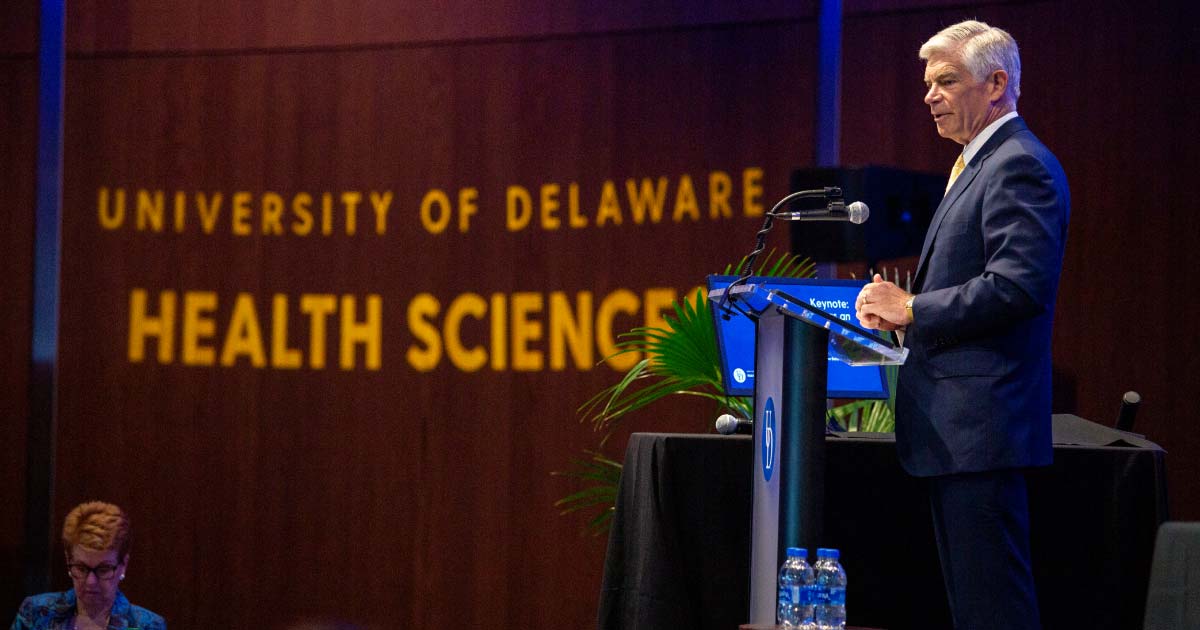
Stern Summit paves way for future of healthcare workforce
Photos by Ashley Barnas June 21, 2022
Health leaders join at CHS to discuss innovations in healthcare workforce
The future of the healthcare workforce and what it could and should be was the focus of the first-ever Stern Future Healthcare Workforce Summit, which brought healthcare, technology and finance leaders together for a daylong event hosted by the University of Delaware College of Health Sciences.
Funded by the generosity of UD alumni Andrew M. Stern, Class of 1970 and Sabina B. Stern, Class of 1971, the Stern Summit was hosted May 17 at the Audion in STAR Tower and streamed online for virtual attendees. Before the presentations began, Andy Stern shared his own insights.
“The healthcare leaders of the future are our youngest generations,” Stern said. “Businesses such as CVS, Target Clinic and Uber Health will require hundreds of thousands of trained workers as they shape the future of healthcare. It’s important we determine who will become the health professionals who manage these innovations.”
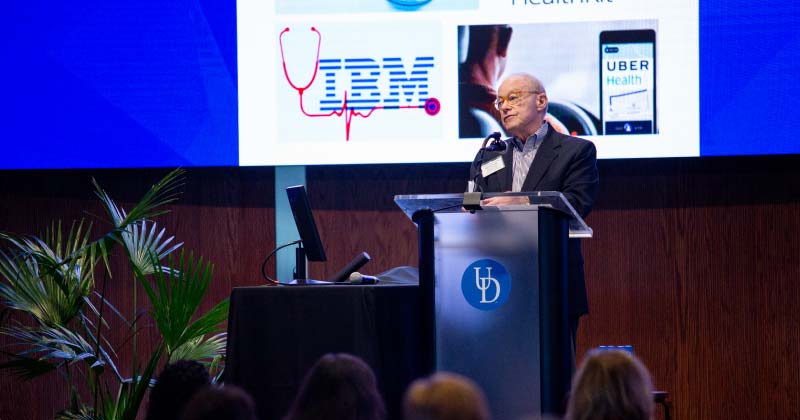
The summit brought together many UD alumni involved in healthcare workforce development in Washington, D.C., and across the country. The intent of the summit was to explore what the future of healthcare might look like given the technological advances that are now transforming healthcare.
Given these technology changes, the event focused on what the future workforce needs to look like and what training that workforce needs to be most effective. Most importantly, topics explored how employers, such as hospitals and clinics partners, can work with academic institutions that are training the healthcare workforce to create a workforce that is better matched to the future needs and demands of healthcare.
Healthcare as an economic driver
The keynote speech, “Healthcare as an Economic Driver,” was presented by former UD President Patrick Harker, who is currently president and CEO of Federal Reserve Bank Philadelphia. Harker emphasized how the healthcare workforce will continue as a rising contributor to economic growth and the importance of businesses to prepare for the upcoming needs and changes in healthcare.
“More must be done to support healthcare workers as the economy changes,” Harker said. “In 1990, there were 8 million healthcare workers in the United States. We are now more than doubled over 16 million, as it is the largest single employment segment in our economy. The last two years demonstrated not only how important the healthcare sector is to our national fabric, but also how extraordinarily important it is to our economy as well.”
Harker suggested the importance of factoring in anchor institutions, which are defined as colleges and medical institutes, both critical to driving economic activity. The research and development of these institutions generate large amounts of new business, are the largest employers in their region and are generally recession resistant.
The Federal Reserve Bank is implementing a tool called the Anchor Economy Dashboard: a first-ever national dashboard that captures the importance of anchor institutions across each state or region and the businesses they are connected to. This tool also calculates an anchor institution reliance score for each region, showcasing how dependent that economy is on local medical institutions.
“This state is quite reliant on anchor institutions,” Harker said. “Delaware has 38 anchor institutions that create 65,316 jobs directly, indirectly and induced. These jobs are supported by hospitals and medical institutes throughout the state.”
The Federal Reserve Bank is committed to a larger impact for the future of healthcare. As the largest employer of economists in the world, the Federal Reserve Bank was able to act when the pandemic hit to get money into the hands of businesses. These banks also invest in low-income housing, job training and transportation, childcare and various other contributors to aid the workforce.
Connected health
Following Harker’s presentation, Robin Goldsmith, UD alumnus (Class of 1993) and health innovation principal for Verizon, presented his speech about the future of connected health via Zoom.
“There will be four key shifts in the future of healthcare,” Goldsmith said. “These will be centered on connected hospitals of the future, the patient experience, protected health information and streamlined virtual care.”
Goldsmith highlighted how connected health will be led by elevated consumer expectations where 65% of consumers now expect connected experiences in their interactions with healthcare providers. Venture funding for digital health companies was at a record-breaking high of $29.1 billion in 2021, further supporting the increased consumer value of connected health.
To conclude his presentation, Goldsmith hinted at further attention from attendees to explore how these four major changes in healthcare can be made sustainable. He emphasized the benefits digital health will continue to bring through enhanced collaboration, increased access to care, decreased costs and improved health quality through timely intervention.
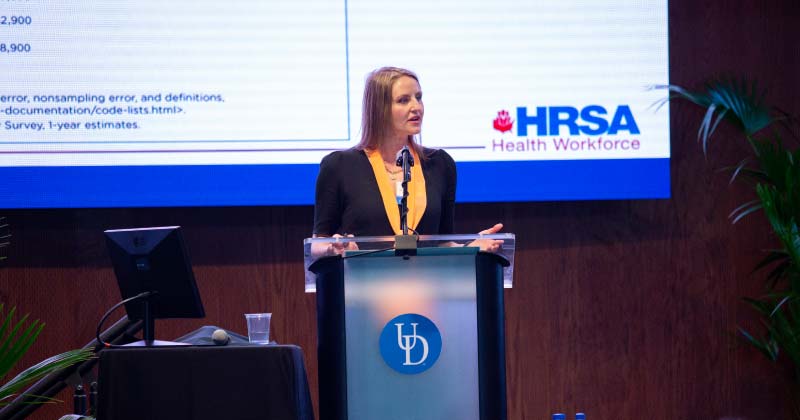
Laying the foundation
Michelle Washko, UD alumna (Class of 2001) and director of the National Center for Health Workforce Analysis, discussed setting the stage for the larger picture of workforce development. Washko explored the changes and consistencies in the labor market before the start of the pandemic and today.
“In 2019, the healthcare industry was one of the largest and fastest growing sectors in the U.S.,” Washko said. “Even so, there were several policy issues we dealt with then and are still facing today. These persistent policy issues consist of adequacy, access, distribution and quality.”
An aging population of baby boomers contributes to issues of the healthcare workforce, increasing demand for growth while historically low birthrates simultaneously decrease supply. This is further exacerbated by many women leaving the workforce to take care of children when the pandemic began.
Though it may appear to be an effective solution to recruit healthcare workers from other countries, this leads to long-term consequences.
“We’re all connected,” Washko said. “We can take help from other countries to solve our immediate problems, but we will pay for it later because we are still part of a globally connected health network. Instead of taking nurses from elsewhere, we should prioritize growing our own.”
Healthcare after COVID-19
The featured luncheon speaker, Bertalan Meskó, director of the Medical Futurist Institute and a professor at Semmelweis Medical School in Budapest, Hungary, attended virtually. He first presented a video, “Healthcare After COVID-19: Preparing the Workforce for a New Norm.”
Meskó explained three different phases in the technological transformation of healthcare: how it began before the pandemic, how the pandemic created need for change and how the future will be shaped.
“Things from science fiction are becoming real,” Meskó said. “Innovations are growing such as 3D printed houses and companies using exoskeletons for workers to lift huge weights, essentially becoming Iron Man in their day-to-day jobs. Our job at the Medical Futurist Institute is to essentially do the opposite of archaeologists, to help us anticipate the future innovations in healthcare.”
Even the roles connected across physicians, patients and doctors are changing under these new circumstances. Priorly seen as a passive part of the experience, patients now contribute to the medical team as an active participant in shaping and understanding their own health.
“We all need to learn how to work together in this new environment,” Meskó said. “Now, patients can look at the data and work with doctors together. Patients bring value to the table and will become an increasingly larger part of the medical team.”
In the future, there will be essential skills for adapting to new technologies in the healthcare workforce. These skills will encompass digital literacy, teamwork, coaching, patient partnership and a few others. The overall goal is to use these skills and technologies for the benefit of the patient.
Meskó then discussed the next new member of the medical team: artificial intelligence.
“AI will not replace medical professionals,” Meskó stressed. “Those medical professionals who use AI will replace those who do not – that is how simple this change is.”
Meskó concluded his presentation by taking questions from summit attendees.
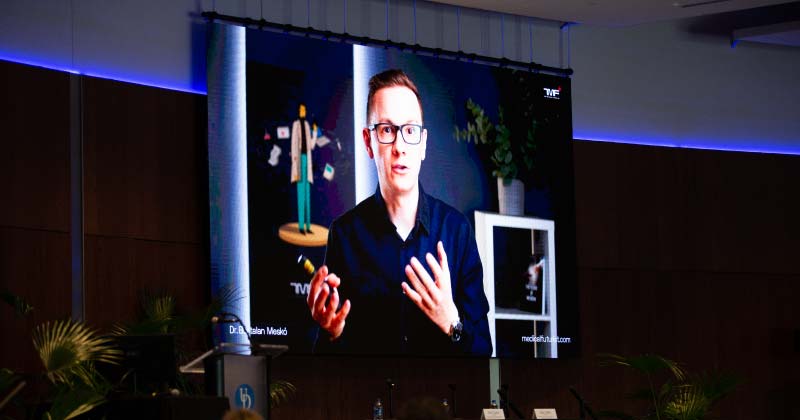
Interprofessional approaches to workforce
The fifth presentation, “Interprofessional Approaches to Workforce,” was a panel discussion moderated by Elisa Arespacochaga, vice president of clinical affairs and workforce at the American Hospital Association. The panel included Darla Coffey, president and CEO of the Council on Social Work Education and chair of NCICLE, and Sheri Cosme, director of the Practice Transition Accreditation Program at the American Nurses Credentialing Center and past chair of NCICLE.
NCICLE, which stands for the National Collaborative for Improving the Clinical Learning Environment, serves as a collective team of organizations interested in improving education experience and patient care outcomes within clinical learning environments.
“Our collaboration is focused on influencing an interprofessional environment to change the way of the workplace for future generations,” Arespacochaga said. “This will occur through teamwork across many disciplines such as information technology, data research, doctors and much more.”
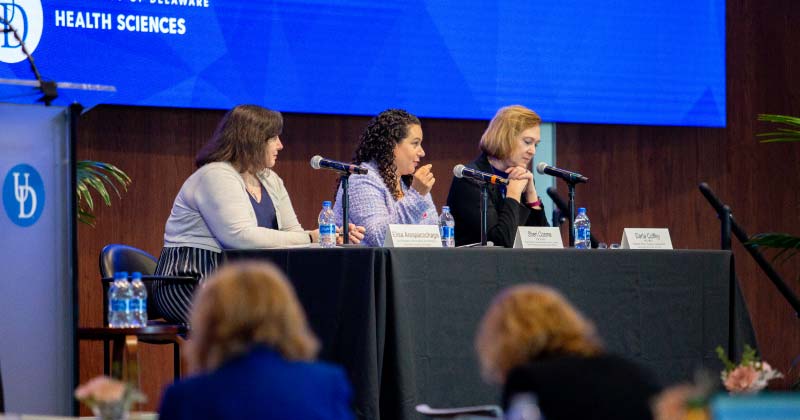
The panel pushed the importance of students igniting the growth of interprofessional teams when they reach the workforce.
“What students learn in the field truly carries them forward,” Coffey said. “Creating a collaborative clinical work environment early on is so important to their growth.”
In reaction to the current stressors healthcare workers face, the panel concluded the future workforce won’t tolerate the current system of work hours, which is heavily void of breaks and includes insufficient time for mental health recovery. These leaders will prioritize the reduction of burnout, sufficient break and vacation plans, and drawing in new voices to become parts of conversations leading future innovations.
Looking forward, Cosme suggested a call to action to better understand how well anyone’s team is handling their work environment. “Go on to NCICLE’s website and pick a document to try together with your team,” Cosme said. “This will provide you an opportunity to determine how well you work in a team environment.”
Education to practice
The final presentation was a second panel discussion focused on designing the future workforce, moderated by Robyn Begley, CEO of the American Organization for Nursing Leadership and senior vice president and chief nursing officer for the American Heart Association. Panelists included Kathleen McGrow, chief nursing information officer of Microsoft Health and Life Sciences; Roy L. Simpson, assistant dean of technology management and professor at the Nell Hodgson Woodruff School of Nursing at Emory University; and George A. Zangaro, chief policy and science officer for the American Association of Colleges of Nursing.
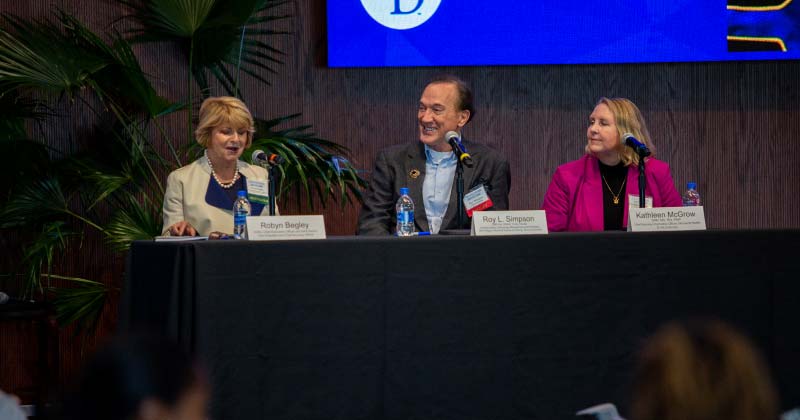
Advancing educational preparation is a critical step in designing the workforce of the future. Out of 62% of healthcare workers who stated mental health has an impact on their work, only 51% said they were emotionally healthy at the beginning of 2021. This number dipped even further in August to 43%. Many of the employees, especially nurses, stated they were overworked, exhausted and often feeling undervalued for their commitment.
“In this time of great uncertainty, I am hopeful we have the skills and passion to take care of the emotional health of our communities, but this is going to require change,” Begley said.
“Recently, a bill has been pushed out for the future advancement of academic nursing,” Zangaro said. “It requests a billion dollars to go to schools of nursing to enhance the workforce for hiring and retaining diverse faculty, modernization of nursing education and support for future nursing scientists and researchers.”
Educators can benefit from the use of new technologies and preparation by updating curriculum that enhances student learning. Even simply incorporating the use of telehealth in schools helps prepare students for the transition to the workforce.
“In order for these new technologies to have a large impact, we must involve the end user’s goals up front,” Begley said. “This will maximize adoption of the new technology by being user friendly.”
According to recent statistics, only 9% of nurses felt competent about entering their careers. The panel suggested that it is critical now more than ever that we reinvent the educational curriculum for nursing and introduce new methods of teaching such as engaging students in simulation technology.
Table talks
To conclude discussions for the Stern Summit, attendees were separated into groups for focused conversations. This was designed to be an extension of the event, in which attendees were able to interact with each other to come up with ideas and reflect on the presentations.
Rita Landgraf, Distinguished Health and Social Services Administrator in Residence as well as director of the Partnership for Healthy Communities, facilitated the table talks portion. Landgraf highlighted how “the summit has increased collective understanding of key issues that impact the current and future health industry” with a specific focus on the workforce.
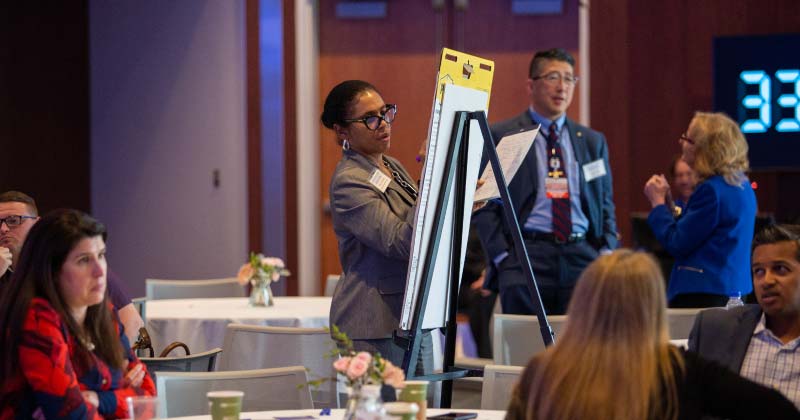
“After the focused conversations wrapped up, facilitators were invited to share a summary of decisional changes for the healthcare workforce ahead,” Landgraf said. “These recommendations will be synthesized to be shared with attendees to promote continued collective engagement for advancement in educating and supporting the future workforce.”
Attendees further proposed a call to action to reach out after the event with any additional ideas in preparation for the next gathering.
Kathleen S. Matt, dean of the College of Health Sciences, reflected on the impact of the event.
“Today was an important meeting,” Matt said. “We need to work very intentionally on educating and training the next generation of healthcare workforce. We need hospitals and clinical sites to work directly with academic institutions to co-design the workforce of the future. Today was the beginning of that conversation, and the table talks were the beginning of mapping the plan for our work ahead. We look forward to the next steps together.”
Contact Us
Have a UDaily story idea?
Contact us at ocm@udel.edu
Members of the press
Contact us at 302-831-NEWS or visit the Media Relations website

